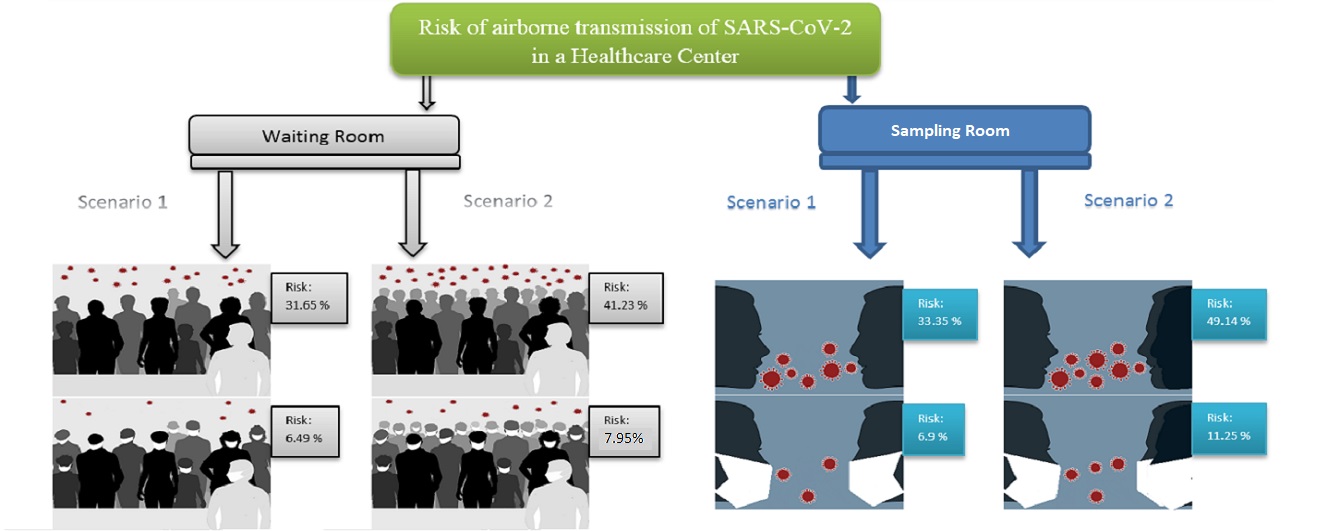Volume 13, Issue 4 (12-2023)
J Health Saf Work 2023, 13(4): 779-796 |
Back to browse issues page
Download citation:
BibTeX | RIS | EndNote | Medlars | ProCite | Reference Manager | RefWorks
Send citation to:



BibTeX | RIS | EndNote | Medlars | ProCite | Reference Manager | RefWorks
Send citation to:
Ahmadi Jalaldehi P, Yavarian J, Golbabaei F, Kalantary S, Rahimi Foroushani A, Abbaslou H. Risk Assessment of Airborne Transmission of a Viral Infection in a Healthcare Center in Tehran: A Cross-sectional Study of Covid-19 During the Pandemic. J Health Saf Work 2023; 13 (4) :779-796
URL: http://jhsw.tums.ac.ir/article-1-6909-en.html
URL: http://jhsw.tums.ac.ir/article-1-6909-en.html
Pourya Ahmadi Jalaldehi1 
 , Jila Yavarian2
, Jila Yavarian2 
 , Farideh Golbabaei1
, Farideh Golbabaei1 
 , Saba Kalantary1
, Saba Kalantary1 
 , Abbas Rahimi Foroushani3
, Abbas Rahimi Foroushani3 
 , Hossein Abbaslou *
, Hossein Abbaslou * 
 4
4

 , Jila Yavarian2
, Jila Yavarian2 
 , Farideh Golbabaei1
, Farideh Golbabaei1 
 , Saba Kalantary1
, Saba Kalantary1 
 , Abbas Rahimi Foroushani3
, Abbas Rahimi Foroushani3 
 , Hossein Abbaslou *
, Hossein Abbaslou * 
 4
4
1- Department of Occupational Health Engineering, School of Public Health, Tehran University of Medical Sciences, Tehran, Iran
2- Department of Virology, School of Public Health, Tehran University of Medical Sciences, Tehran, Iran
3- Department of Epidemiology and Biostatistics, School of Public Health, Tehran University of Medical Sciences, Tehran, Iran
4- Department of Occupational Health Engineering, School of Public Health, Tehran University of Medical Sciences, Tehran, Iran ,h.abbaslou95@gmail.com
2- Department of Virology, School of Public Health, Tehran University of Medical Sciences, Tehran, Iran
3- Department of Epidemiology and Biostatistics, School of Public Health, Tehran University of Medical Sciences, Tehran, Iran
4- Department of Occupational Health Engineering, School of Public Health, Tehran University of Medical Sciences, Tehran, Iran ,
Abstract: (621 Views)
Introduction: The COVID-19 pandemic has been a significant global health challenge. Primary care services, such as screening health centers, were crucial in identifying infected individuals. However, these centers were often crowded and posed a high risk to staff and non-COVID-19 patients. This study aims to assess the risk of airborne transmission of SARS-CoV-2 in such settings through simulation.
Material and Methods: In this study, waiting and sampling rooms of a COVID-19 healthcare center were simulated using different scenarios. Then, the Quanta emission rate was estimated using the viral load in the sputum of infected individuals. Finally, the airborne transmission risk of SARS-CoV-2 was determined using the Wells-Riley method for scenarios of wearing and without masks.
Results: The study showed that the Quanta emission rate in an unmodulated speaking activity was higher than other expiratory activities in both units (p <0.001). Also, the total amount of Quanta was slightly higher in the sampling room than in the waiting room, which was not statistically significant. On the other hand, the calculation of transmission risk showed that the probability of airborne virus transmission in the sampling room was higher (about 2 to 8%). In addition, wearing masks reduced the possibility of airborne transmission of the virus significantly (77 to 81%).
Conclusion: This study shows that the level of risk in the sampling and waiting rooms is moderate. Masks also significantly reduce the possibility of airborne transmission of SARS-CoV-2. Taking appropriate health and safety measures such as avoiding crowds, wearing masks, whispering, and monitoring social distancing can reduce the plausibility of airborne transmission of the SARS-CoV-2 virus.
Material and Methods: In this study, waiting and sampling rooms of a COVID-19 healthcare center were simulated using different scenarios. Then, the Quanta emission rate was estimated using the viral load in the sputum of infected individuals. Finally, the airborne transmission risk of SARS-CoV-2 was determined using the Wells-Riley method for scenarios of wearing and without masks.
Results: The study showed that the Quanta emission rate in an unmodulated speaking activity was higher than other expiratory activities in both units (p <0.001). Also, the total amount of Quanta was slightly higher in the sampling room than in the waiting room, which was not statistically significant. On the other hand, the calculation of transmission risk showed that the probability of airborne virus transmission in the sampling room was higher (about 2 to 8%). In addition, wearing masks reduced the possibility of airborne transmission of the virus significantly (77 to 81%).
Conclusion: This study shows that the level of risk in the sampling and waiting rooms is moderate. Masks also significantly reduce the possibility of airborne transmission of SARS-CoV-2. Taking appropriate health and safety measures such as avoiding crowds, wearing masks, whispering, and monitoring social distancing can reduce the plausibility of airborne transmission of the SARS-CoV-2 virus.
Type of Study: Research |
Received: 2024/01/1 | Accepted: 2023/12/31 | Published: 2023/12/31
Received: 2024/01/1 | Accepted: 2023/12/31 | Published: 2023/12/31
Send email to the article author
| Rights and permissions | |
 |
This work is licensed under a Creative Commons Attribution-NonCommercial 4.0 International License. |




